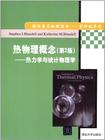热物理概念
出版时间:2012-8 出版社:布隆代尔(Stephen J. Blundell)、 布隆代尔(Katherine M. Blundell) 清华大学出版社 (2012-08出版) 作者:Stephen J.Blundell, Katherine 页数:493
Tag标签:无
内容概要
《国际著名物理图书·影印版系列:热物理概念·热力学与统计物理学(第2版)》详细介绍了作为热力学和统计物理学基础的一些主要原理以及它们的应用。书中以非常清晰的方式介绍和讨论了热力学和统计物理学中一些核心的概念,通过非常丰富的实例来说明新的概念、方法和原理,对于相关的历史背景和发现过程也作了比较具体的描述。该书关于概念、原理和方法的应用涉及天体物理,大气物理,信息和通信理论,凝聚态物理等众多学科,体现了基本理论和方法的广泛适用性。此外,每章末包含了小结,可以深入学习的文献简介以及许多的习题,有助于加深对概念、原理和方法的理解。 《国际著名物理图书·影印版系列:热物理概念·热力学与统计物理学(第2版)》可作为综合大学或师范院校物理学以及相关专业的热力学统计物理课程的教材。
作者简介
作者:(英国)布隆代尔(Stephen J.Blundell) (英国)布隆代尔(Katherine M.Blundell)
书籍目录
前言 第2版前言 Ⅰ准备知识 1引言 1.1摩尔是什么? 1.2热力学极限 1.3理想气体 1.4组合问题 1.5本书的计划 练习 2热量 2.1热量的定义 2.2热容量 练习 3概率 3.1离散概率分布 3.2连续概率分布 3.3线性变换 3.4方差 3.5线性变换和方差 3.6独立变量 3.7二项分布 进一步读物 练习 4温度和Boltzmann因子 4.1热平衡 4.2温度计 4.3微观态和宏观态 4.4温度的统计定义 4.5系综 4.6正则系综 4.7 Boltzmann分布的应用 进一步读物 练习 Ⅱ气体动理学理论 5 Maxwell—Boltzmann分布 5.1速度分布 5.2速率分布 5.3实验验证 练习 6压强 6.1分子分布 6.2理想气体定律 6.3 Dolton定律 练习 7分子泻流 7.1流密度 7.2泻流 练习 8平均自由程和碰撞 8.1平均碰撞时间 8.2碰撞截面 8.3平均自由程 Ⅲ输运和热扩散 9气体的输运性质 9.1黏性 9.2热导率 9.3扩散 9.4更细致的理论 进一步读物 练习 10热扩散方程 10.1热扩散方程的导出 10.2一维热扩散方程 10.3稳态 10.4球的热扩散方程 10.5 Newton冷却定律 10.6 Prandtl数 10.7热源 10.8粒子扩散 练习 Ⅳ第一定律 11能量 11.1一些定义 11.2热力学第一定律 11.3热容量 练习 12等温过程和绝热过程 12.1可逆性 12.2理想气体的等温膨胀 12.3理想气体的绝热膨胀 12.4绝热大气 练习 Ⅴ第二定律 13热机和第二定律 13.1热力学第二定律 13.2 Carnot热机 13.3 Carnot定理 13.4 Clausius表述与Kelvin表述的等价性 13.5热机实例 13.6逆向运行的热机 13.7 Clausius定理 进一步读物 练习 14熵 14.1熵的定义 14.2不可逆变化 14.3再论第一定律 14.4 Joule膨胀 14.5熵的统计基础 14.6混合的熵 14.7 Maxwell妖 14.8熵和概率 练习 15信息论 15.1信息和Shannon熵 15.2信息和热力学 15.3数据压缩 15.4量子信息 15.5条件概率和联合概率 15.6 Bayes定理 进一步读物 练习 Ⅵ热力学应用 16热力学势 16.1内能U 16.2焓H 16.3 Helmholtz函数F 16.4 Gibbs函数G 16.5约束 16.6 Maxwell关系 练习 17杆,气泡和磁体 17.1弹性杆 17.2表面张力 17.3电偶极子和磁偶极子 17.4顺磁性 练习 18第三定律 18.1第三定律的不同表述 18.2第三定律的一些结果 练习 Ⅶ统计力学 19能量均分 19.1能量均分定理 19.2应用 19.3所作假设 19.4 Brown运动 练习 …… Ⅷ超越理想气体 Ⅸ 特殊专题 A基本常数 B有用的公式 C有用的数学 D电磁谱 E一些热力学定义 F热力学展开公式 G约化质量 H主要符号总表 参考文献 索引
章节摘录
版权页: 插图: 1.2 The thermodynamic limit In this section, we will explain how the large numbers of molecules ina typical thermodynamic system mean that it is possible to deal withaverage quantities. Our explanation proceeds using an analogy: imaginethat you are sitting inside a tiny hut with a fiat roof. It is rainingoutside, and you can hear the occasional raindrop striking the roof. Theraindrops arrive randomly, so sometimes two arrive close together, butsometimes there is quite a long gap between raindrops. Each raindroptransfers its momentum to the roof and exerts an impulse2 on it. If youknew the mass and terminal velocity of a raindrop, you could estimatethe force on the roof of the hut. The force as a function of time wouldlook like that shown in Fig. 1.1(a), each little blip corresponding to theimpulse from one raindrop. Now imagine that you are sitting inside a much bigger hut with a fiatroof a thousand times the area of the first roof. Many more raindropswill now be falling on the larger roof area and the force as a function oftime would look like that shown in Fig. 1.1(b). Now scale up the areaof the fiat roof by a further factor of one hundred and the force wouldlook like that shown in Fig. 1.1. Notice two key things about thesegraphs: (1) The force, on average, gets bigger as the area of the roof getsbigger. This is not surprising because a bigger roof catches moreraindrops. (2) The fluctuations in the force get smoothed out and the force lookslike it stays much closer to its average value. In fact, the fluctuations are still big but, as the area of the roof increases, they growmore slowly than the average force does. The force grows with area, so it is useful to consider the pressure, whichis defined as The average pressure due to the falling raindrops will not change as thearea of the roof increases, but the fluctuations in the pressure will decrease. In fact, we can completely ignore the fluctuations in the pressurein the limit that the area of the roof grows to infinity. This is preciselyanalogous to the limit we refer to as the thermodynamic limit. Consider now the molecules of a gas which are bouncing around in acontainer. Each time the molecules bounce off the walls of the container,they exert an impulse on the walls. The net effect of all these impulses isa pressure, a force per unit area, exerted on the walls of the container. Ifthe container were very small, we would have to worry about fluctuationsin the pressure (the random arrival of individual molecules on the wall,much like the raindrops in Fig. 1.1(a)). However, in most cases that onemeets, the number of molecules in a container of gas is extremely large,so these fluctuations can be ignored and the pressure of the gas appearsto be completely uniform. Again, our description of the pressure of thissystem can be said to be "in the thermodynamic limit", where we havelet the number of molecules be regarded as tending to infinity in such away that the density of the gas is a constant.
编辑推荐
《热物理概念:热力学与统计物理学(第2版)》可作为综合大学或师范院校物理学以及相关专业的热力学统计物理课程的教材。
图书封面
图书标签Tags
无
评论、评分、阅读与下载
用户评论 (总计9条)
- 相比国内热学与统计物理教材,更加注重概念和基础,注重知识的应用,与当今前沿贴合较为紧密。
- 教材浅显易懂,并且在开头对概率论做了一些简单描述。基本没啥基础的也能看。
- 书很不错,内容通俗易懂,有很广的知识拓展
- 通俗易懂,讲解透彻,非常好的入门教材
- 学校作为教材的;起点低;层次高
- 啊呀,英文版啊,完全看得懂,买前没搞清楚!
- 今年刚开始用这本教材,老外写的热统和国内的某些教材就是不一样,门槛儿低但是内容却不低,语言通俗易懂,课后习题很开放,章节内容上的排序可见其独有匠心,不论是做教材还是自学都值得推荐一下
- 鞠国兴老师首次引入国内课堂教学的教材,正在用,很棒
- 这是牛津大学物理系统计物理课程的教材,出版后得到广泛好评.概念清晰,实例丰富,应用广泛,值得选为教材或作自学之用.
